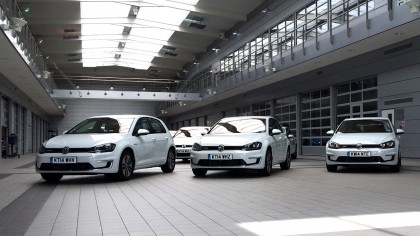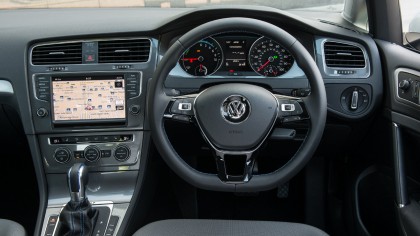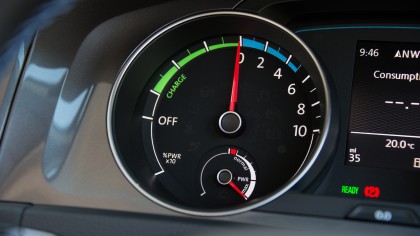Volkswagen e-Golf is the ultimate stealthy electric car
Standard hatchback looks combined with the pure-electric driving experience

Are you buying an electric car to shout about your progressive attitude to personal transport?
Or are you more interested in the real-world benefits and happy to fly under the radar in your new EV?
If the latter sounds like you, Volkswagen's new e-Golf may well be your bag. Where the likes of BMW's radical i3 screams 'EV' from carbon-fibre top to aluminium tail, the e-Golf looks just like, well, any other Golf.
Barring some subtle badging and wheel design, you'd never know from the outside that this Golf is pure-electric and powered by lithium cells. The same goes for the cabin, which gives little away regarding the transistion from combustion to battery electric.

This is as subtle as next-gen motoring gets. You don't even lose any appreciable boot space. Only the secondary lower storage tray below the multi-position boot floor loses a little capacity.
All electric
That's because the e-Golf is based, like all other Golfs, on Volkswagen's clever MQB architecture. It's been concieved from day one to allow all kinds of power sources. That means the e-Golf's lithium battery is fully integrated into the chassis floor, rather than being a great lump in the back.
Anyway, before we tell you what the new e-Golf is actually like, let's cover some of the basic tech specs. For the e-Golf, out goes any kind of combustion engine. In comes a 115hp electric motor and a 24KWh lithium battery pack.
Sign up for breaking news, reviews, opinion, top tech deals, and more.

All in, the e-Golf weighs 1,510kg has an official NEDC range of 118 miles and starts at £25,845 in the UK and $36,265 in the USA. Performance-wise, we're talking Zero to 62mph in 10.4 seconds and a top speed limited to 87mph.
On the road
First impressions, then. Once you look past the bog standard Golf aesthetics, the first thing that hits you is the solidity and refinement of the e-Golf. It almost doesn't feel mechanical at all.
There's very little noise from the powertrain and the body structure is very stiff and creak / rattle free.
Step off from a standing start feels brisk, like most electric cars. By the time you're up to motorway speeds, it does feel a little gutless. At about 60mph and beyond, you also notice heightened road and wind noise. This is really an illusion. It's the lack of engine noises that makes all the other sounds stand out.

You'll also notice just how flat the e-Golf corners and how composed it feels. Much of that is down to that big battery.
Firstly, it's mounted in the chassis floor which makes for a very low overall centre of gravity. The sheer weight of the thing also helps to settle the e-Golf's ride, giving it the gait of a larger car – but in a good way.
The other thing that pops into your head initially is what's the point of all this? Isn't the Golf the ultimate jack of all trades? What are you supposed to do with a Golf that will only go 100 miles and takes four hours to charge, even with an updrated 30 amp power supply (it's about double that on a standard UK / European socket, double again on a standard US socket)?
Terrific town car
Well, there's no doubt the e-Golf is not as flexible an all-rounder as the standard combustion model. It's simply not fit for long distance travel. But then lots of cars are never used for long distance travel, so that's OK.
Instead, the e-Golf makes huge sense as an urban and suburban runabout. Pretty quickly, you get used to the instant, fuss-free electrified performance and combustion cars seem like rather preposterous, steampunk creations.
A tank of explosive fuel being noisily burned somewhere in a box up front? Bonkers compared to the effortless serenity of the e-Golf.

Then there's the day-to-day running costs. Charging the e-Golf is dead cheap compared to filling up at the pumps, broader taxation on EVs is currently very low and for the most part, electric cars are simpler mechanically. There's so much less to go wrong.
Now, there are counter arguments to much of that. The actual cost of ownership is very complex and involves things like residuals that are hard to predict for this new class of car.
It's all very well being cheaper to run, but it won't count for much if you get walloped with an additional £5,000 in depriciation if it turns out nobody wants to buy one of the first generations of electric cars second hand.
Zero emissions
Likewise, while EVs should generally prove ultra reliable, the one worry is that big-money battery. That said, the e-Golf's battery does have an eight-year, 160,000km (99,419 miles) warranty, which helps.
Suffice to say, then, that the overall value proposition is unclear. What's not in doubt is that the e-Golf is clearly a more pleasant device for zipping about town than the combustion models and that it will do that with absolutely zero local emissions.

Again, the broader argument regards emissions is complex and much depends on things like local electricity grid mixes and availability of renewable electricity sources.
So, the e-Golf cerrtainly isn't for everyone. But nor is it close to being pointless. For a certain kind of person looking for a car for urban and suburban duties, it gets the job done beautifully and without drawing any attention to itself. It's the ultimate stealth EV and for some that will be very a very attractive propositon.
Technology and cars. Increasingly the twain shall meet. Which is handy, because Jeremy (Twitter) is addicted to both. Long-time tech journalist, former editor of iCar magazine and incumbent car guru for T3 magazine, Jeremy reckons in-car technology is about to go thermonuclear. No, not exploding cars. That would be silly. And dangerous. But rather an explosive period of unprecedented innovation. Enjoy the ride.